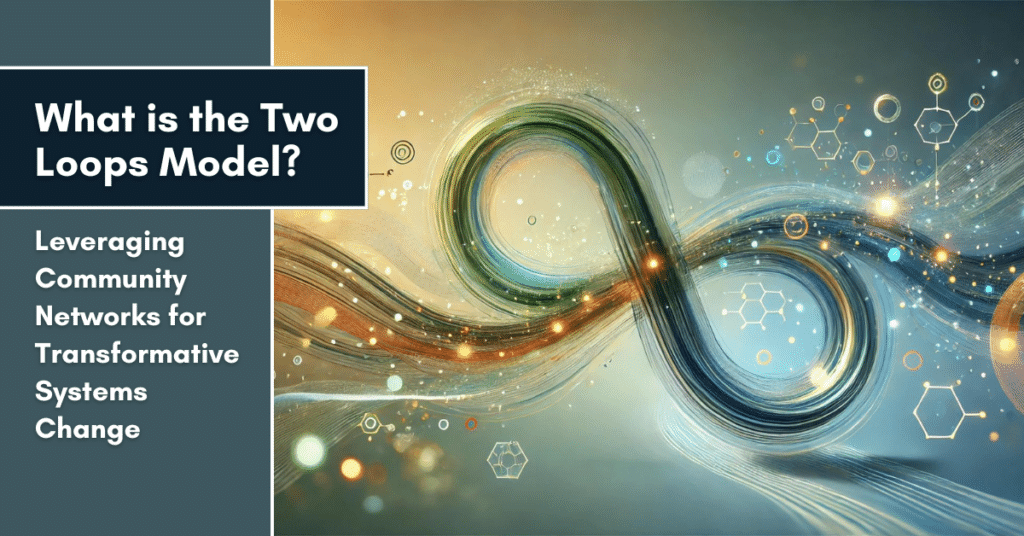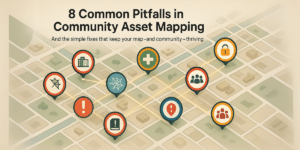In today’s rapidly evolving world, communities are increasingly called upon to navigate complex transitions. Whether it’s moving toward sustainable energy, addressing systemic inequities, or reimagining local economies, the challenge is not just to survive but to thrive in the face of change.
The Two Loops model, developed by the Berkana Institute, offers a powerful framework for understanding and guiding these transitions. When applied to community networks, this model can help us support the emergence of new systems while gracefully composting the old.
Here’s an introduction to this powerful model and the ways it can support your community network development.
Table of Contents
What is the Two Loops Model?
At its core, the Two Loops model describes the lifecycle of systems—how the old, dominant system begins to decline while a new, emergent system rises to take its place. This model is crucial for community networks, which are often at the forefront of driving systemic change.
The model consists of two main loops:
- The Dominant System: This is the established system that has reached its peak and is beginning to decline.
- The Emergent System: This is the new, innovative system that is growing and eventually superseding the old.
Within these loops, various roles are essential to the transition:
- Pioneers: Innovators who are at the forefront of developing and experimenting with new ideas.
- Stabilizers: Those who manage the decline of the old system, ensuring a smooth transition and minimizing harm.
- Bridge Builders: Actors who bridge the gap between the old and new systems, helping to transfer valuable knowledge and resources.
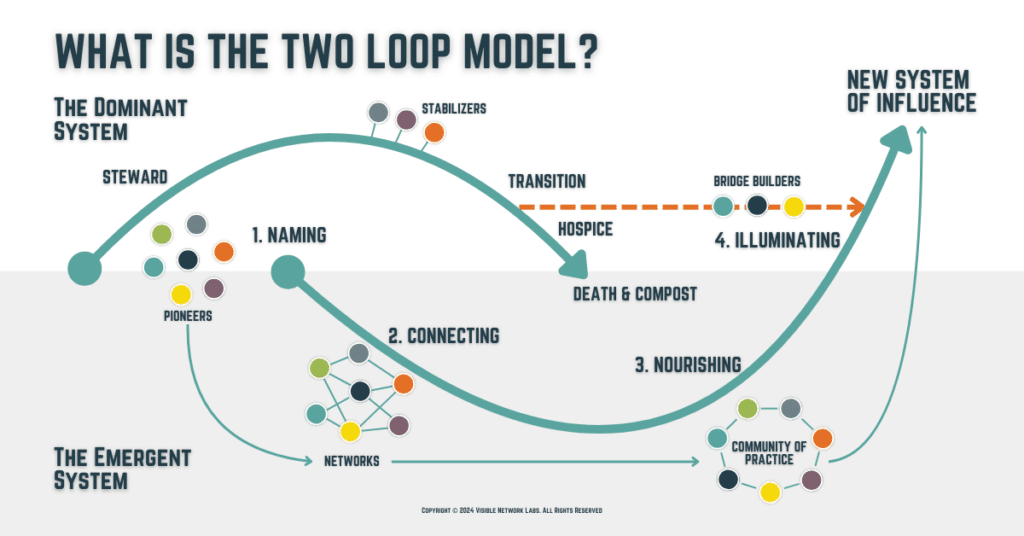
From Networks to Systems of Influence: The Role of Emergence
The Berkana Institute emphasizes that true change doesn’t happen by merely scaling individual efforts but through the process of emergence. Emergence occurs when local, separate efforts connect, grow into communities of practice, and ultimately coalesce into a new, powerful system with greater influence than the sum of its parts. This process highlights the importance of fostering critical connections rather than just seeking critical mass.
Margaret Wheatley and Deborah Frieze, who conceptualized the Two Loops model, argue that “the world doesn’t change one person at a time. It changes as networks of relationships form among people who discover they share a common cause and vision of what’s possible.”
This insight is particularly relevant for community networks, which are uniquely positioned to connect local innovators, nourish their efforts, and illuminate their successes to a broader audience.
Applying the Two Loops Model to Community Networks
Community networks are essential in driving systemic change, and the Two Loops model provides a strategic framework to guide these efforts. Here’s how to apply the model effectively:
1. Naming and Connecting Pioneers
- Identify and Acknowledge Innovators: The first step in the Berkana Institute’s approach is to name the pioneers. These are the individuals and organizations already engaged in innovative work, often without realizing the broader value of their efforts. Community networks can play a crucial role in recognizing these pioneers and connecting them with others who share their vision.
- Foster Critical Connections: As Wheatley and Frieze point out, “our work is to foster critical connections.” By bringing pioneers together into a network, community networks can create a fertile ground for new ideas to flourish and evolve.
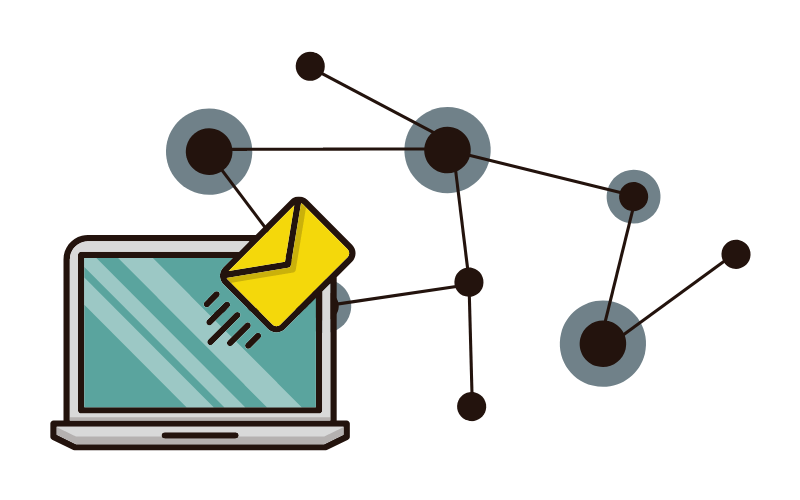
Get our monthly newsletter with resources for cross-sector collaboration, VNL recommended reading, and upcoming opportunities for engaged in the “network way of working.”
2. Nourishing Communities of Practice
- Facilitate Communities of Practice: Once pioneers are connected, the next step is to nourish these connections by helping them transition into communities of practice (CoPs). In CoPs, individuals commit to supporting one another, sharing knowledge, and advancing their collective work. Unlike loose networks, CoPs are deeply collaborative and dedicated to both personal and collective growth.
- Provide Resources and Learning Opportunities: Community networks can nourish these communities by providing resources such as funding, mentorship, technology, and opportunities for shared learning. The Berkana Institute emphasizes that the most significant nourishment often comes from the interactions among pioneers themselves, as they share practices, experiences, and dreams.
3. Illuminating the Emergent System
- Amplify Success Stories: The final step in the Berkana model is to illuminate the work of these pioneering communities. Community networks can help by sharing stories of success and innovation with a wider audience, thus inspiring others and encouraging the adoption of new practices. This is how the emergent system gains visibility and influence.
- Drive Systemic Change: As these communities of practice grow and strengthen, they can eventually lead to the emergence of a new system of influence—a system with the power to effect change at a much larger scale. Community networks play a crucial role in this process by advocating for these new practices and ensuring they become the norm.
Leveraging PARTNER CPRM and Social Network Analysis (SNA)
The PARTNER CPRM (Community Partner Relationship Management) platform and Social Network Analysis (SNA) tools can significantly enhance the effectiveness of the Two Loops model in community networks. Here’s how:
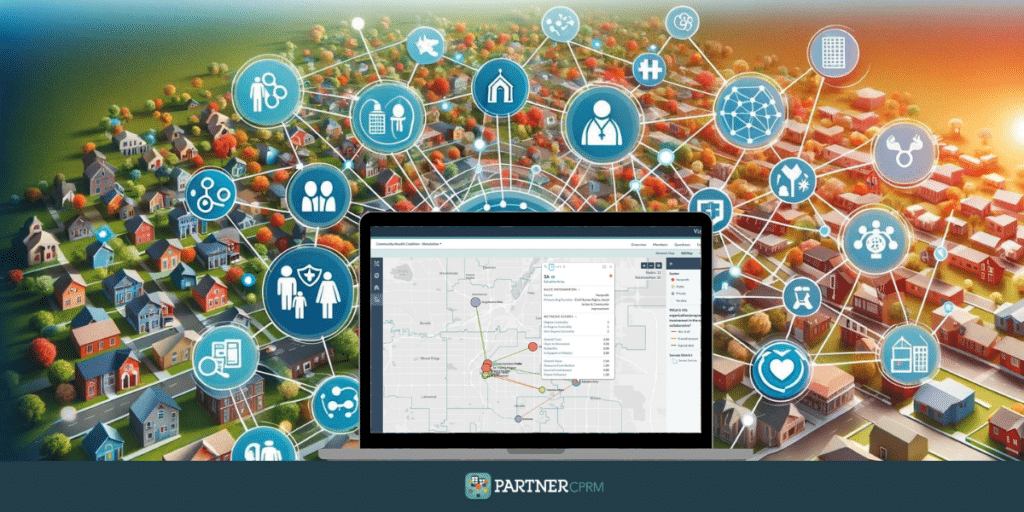
1. Mapping and Analyzing Networks
- Identify Key Actors and Relationships: PARTNER CPRM allows community networks to map out the entire network of individuals and organizations involved in both the Dominant and Emergent systems. By identifying key actors—such as pioneers, stabilizers, and transition guides—SNA can help visualize how these entities are connected, where the strongest ties exist, and where there may be gaps or opportunities for building critical connections.
- Assess Network Health and Influence: SNA provides metrics such as centrality (which indicates influence) and density (which shows cohesion). These metrics are essential for understanding the health of both the Dominant and Emergent systems. For example, a high centrality score among pioneers might suggest that certain innovators are particularly influential in shaping the emergent system, making them crucial nodes in the network.
2. Enhancing Collaboration and Resource Allocation
- Track Resource Flow and Contributions: The PARTNER CPRM platform can track how resources (such as funding, information, and support) flow within the network. This helps ensure that pioneers in the Emergent system have the resources they need while also supporting stabilizers in managing the decline of the Dominant system. SNA can identify bottlenecks or underutilized resources, guiding more effective allocation.
- Strengthen Non-Redundant Ties: Non-redundant ties—connections that bring together otherwise unconnected groups—are crucial for fostering innovation and knowledge transfer. PARTNER CPRM can help identify these critical ties and facilitate their formation, ensuring that ideas and practices can spread across the network, accelerating the emergence of the new system.
3. Monitoring and Supporting the Transition
- Track Changes Over Time: With PARTNER CPRM’s longitudinal data capabilities, community networks can monitor how the network evolves over time. This is particularly valuable for understanding the dynamics of the transition—such as when the Emergent system starts gaining dominance or when additional support might be needed to stabilize the transition.
- Evaluate Trust and Value Perceptions: Trust and perceived value are key indicators of a network’s health. By measuring these within both the Dominant and Emergent systems, community networks can identify areas where trust needs to be built or where value is not being adequately recognized, and take steps to address these issues.

Get our monthly newsletter with resources for cross-sector collaboration, VNL recommended reading, and upcoming opportunities for engaged in the “network way of working.”
4. Strategic Planning and Reflection
- Scenario Planning: Insights from PARTNER CPRM and SNA can be used to develop strategic scenarios, helping community networks anticipate potential challenges and opportunities in the transition. This planning can guide decision-making and resource allocation, ensuring that the network remains adaptive and responsive to changing circumstances.
- Reflective Practice: The Two Loops model, supported by data from PARTNER CPRM and SNA, can serve as a powerful tool for reflective practice. By regularly analyzing the network and reflecting on where their work fits within the Two Loops, community networks can continually refine their strategies and approaches to better support systemic change.
Case Study: A Community Network in Action
Consider a community network focused on transitioning from traditional agriculture to sustainable farming practices. Here’s how the Two Loops model, PARTNER CPRM, and SNA could be applied:
- Naming and Connecting: The network uses PARTNER CPRM to identify local farmers experimenting with organic methods (pioneers) and maps their connections within the region. SNA reveals the most influential innovators and highlights potential gaps in the network.
- Nourishing: The network then provides these farmers with resources—such as access to markets, training in sustainable practices, and opportunities to share their experiences. By tracking resource flow and collaboration through PARTNER CPRM, the network ensures that these resources are effectively distributed.
- Illuminating: Finally, the network uses data from PARTNER CPRM to showcase the success of these farmers, sharing their stories through local media, policy advocacy, and public events. SNA helps measure the growing influence of these practices within the broader community, indicating when the Emergent system of sustainable farming begins to gain dominance.

Conclusion: Embracing the Power of Emergence
The Two Loops model offers a nuanced understanding of how systems change and how community networks can facilitate this process. By focusing on naming, connecting, nourishing, and illuminating, networks can support the emergence of new, more resilient systems. PARTNER CPRM and SNA provide the tools needed to map, analyze, and strategically guide these transitions, ensuring that community efforts are both effective and impactful.
As Wheatley and Frieze remind us, “emergence is the only way change really happens on this planet.” For community networks, this means that the key to driving systemic change lies not in convincing the masses but in fostering the critical connections that allow new systems to emerge and thrive. With the support of PARTNER CPRM and SNA, these networks can navigate the complex dynamics of the Two Loops model, leading to transformative change that is both sustainable and scalable.
Are you ready to harness the power of the Two Loops model in your community network? Together, with the right tools and strategies, we can build the networks, communities, and systems of influence that will shape a better future.
FAQ
Q: What is the Two Loops model?
A: The Two Loops model, developed by the Berkana Institute, is a framework that illustrates how systems change over time. It shows the decline of an old, dominant system and the rise of a new, emergent system. The model emphasizes the roles of pioneers (innovators), stabilizers (who manage the decline), and transition guides (who help bridge the old and new systems) in facilitating this change.
Q: How does the Two Loops model relate to community networks?
A: Community networks are often at the forefront of systemic change. The Two Loops model provides a strategic framework for these networks to support the transition from old systems to new ones. By identifying and connecting pioneers, nourishing communities of practice, and illuminating successful innovations, community networks can drive the emergence of new systems.
Q: What is emergence, and why is it important in the Two Loops model?
A: Emergence is the process by which separate, local efforts connect and evolve into a new, powerful system with greater influence than the sum of its parts. In the Two Loops model, emergence is crucial because it is through this process that the new system gains strength and eventually replaces the old one. Community networks can support emergence by fostering critical connections and enabling collaboration among innovators.
Q: How can PARTNER CPRM and Social Network Analysis (SNA) support the Two Loops model?
A: PARTNER CPRM and SNA are tools that can map and analyze the network of relationships within both the Dominant and Emergent systems. They help identify key actors, assess network health, track resource flows, and monitor changes over time. By using these tools, community networks can strategically guide the transition process, ensuring that resources are effectively allocated, critical connections are made, and the new system gains visibility and influence.
Q: Can the Two Loops model be applied to any type of community network?
A: Yes, the Two Loops model is versatile and can be applied to a wide range of community networks, whether they are focused on social, environmental, economic, or other forms of systemic change. The model is particularly useful in situations where an old system is declining and new, innovative approaches are beginning to emerge.
Q: What are Communities of Practice (CoPs), and why are they important?
A: Communities of Practice (CoPs) are self-organized groups of individuals who share a common work and are committed to supporting each other’s growth and advancing their field of practice. In the Two Loops model, CoPs are essential because they help accelerate the development and spread of new practices within the Emergent system, making it more robust and resilient.
Q: What should a community network do if the transition is not progressing as planned?
A: If the transition is not progressing as planned, the network should revisit the network analysis to identify potential bottlenecks, gaps in resources, or weak connections. It may be necessary to strengthen support for pioneers, enhance collaboration among stabilizers, or amplify the visibility of successful innovations. Regular reflection and adaptive planning are key to navigating challenges in the transition process.
